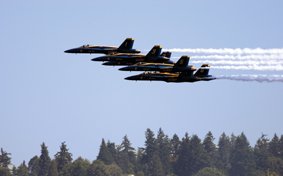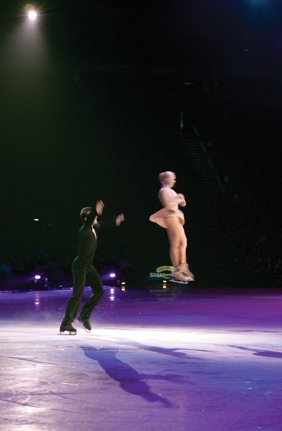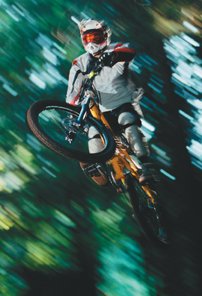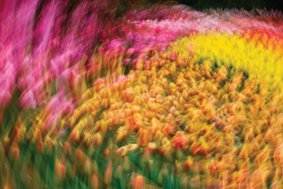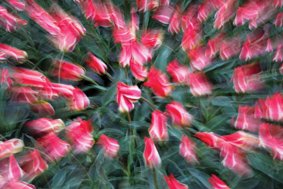Using Shutter Speed Settings
| Shutter Priority, also known as Time Value or TV on some cameras, is the best choice when you want to control how long of an exposure you take and don't care as much about the depth of field. An example of this type of image capture is sports photography, where you really want to freeze the subject in motion. Another is where the wind is blowing, and you want to avoid the blurring of trees, flowers, and grasses. Freezing MotionWhether you're shooting fast-moving cars, athletes, or kids and dogs, stopping the action can make the difference between a successful sharp image and one that appears unsharp due to unwanted motion blur (Figure 2.13). In these situations, a fast shutter speed is required to stop the action and provide sharp detail in the main subject. Figure 2.13. Too slow of a shutter speed can ruin an image with a moving subject.
Unless you're using flash, as a rule a good minimum shutter speed when photographing people is 1/125. When the subject isn't moving quickly, such as the figure skaters shown in Figure 2.14, 1/60 is often enough to capture a sharp image. Flash helps to freeze action much better and is typically used at shutter speeds of 1/60 to 1/250 (or higher), depending on the camera. Figure 2.14. A shutter speed of 1/60 is enough to freeze the movement of these skaters when they aren't moving much.
Faster-moving subjects like cars often need a faster shutter speed, or they require you to use creative techniques at slower speeds, which I cover a bit later. To freeze a car moving at freeway speeds, a shutter speed of 1/250 should be considered a minimum (Figure 2.15). Figure 2.15. A car on the freeway is in sharp focus when shot at 1/250.
Shutter speed also changes with distance. The closer a moving subject is to the camera, the faster shutter speed you need to capture the image. As an example, the image shown in Figure 2.16 was shot at 1/180, even though the planes are going several hundred miles per hour. Had they been closer and filling more of the frame, I would have needed a shutter speed of 1/2000 to freeze the action. Figure 2.16. Even though these jets are moving at hundreds of miles an hour, they are far enough away that a fast shutter speed isn't required.
Emphasizing MotionSometimes freezing the action is exactly the wrong thing to do. For instance, flowing water like that shown in Figure 2.17 takes on a silky, smooth look thanks to a slow shutter speed of one second. Figure 2.17. A one-second exposure has turned this waterfall into a smooth blur.
This technique is also good to show some movement and action in a photo to emphasize the activity. In Figure 2.18 the same 1/60 exposure used in the earlier example (Figure 2.14, in which they were not moving so fast) of the ice skaters now shows the skater in a fast spin, letting the viewer see the speed at which the subject is moving. Again, a sturdy tripod is essential to retain sharpness in stationary objects within the image. Figure 2.18. Using the same 1/60 exposure as Figure 2.14, movement now produces motion blur.
Creative TechniquesCombining motion and sharp detail can make for very compelling images, especially when shooting fast visual spectacles such as sports. The technique of panning is one of the few times when you intentionally move the camera while shooting. In Figure 2.19, the camera moved along with the motorcyle while pressing the shutter button. This provided a sharp image of the motorcyclist with a nicely blurred background to really show the speed. Figure 2.19. Panning the camera with the movement of your subject is an effective method of showing action while keeping your subject in focus.Photo by Laurence Chen
Another use of slower shutter speeds and movement is shown in Figure 2.20. Here I twisted the camera during a long exposure of a 1/2 second at f/32 to give an ordinary photo of tulips an abstract look. Figure 2.20. Intentionally moving the camera during an exposure can produce interesting effects.
You can do something similar by moving the zoom lens in or out during a long exposure (Figure 2.21), adding an explosive look to the image. This works best with bright colors that pull the viewer's eye into the photo. Figure 2.21. Zooming in or out during exposure is another fun technique to experiment with.
|
EAN: 2147483647
Pages: 91
- A View on Knowledge Management: Utilizing a Balanced Scorecard Methodology for Analyzing Knowledge Metrics
- Measuring ROI in E-Commerce Applications: Analysis to Action
- Technical Issues Related to IT Governance Tactics: Product Metrics, Measurements and Process Control
- The Evolution of IT Governance at NB Power
- Governance Structures for IT in the Health Care Industry



